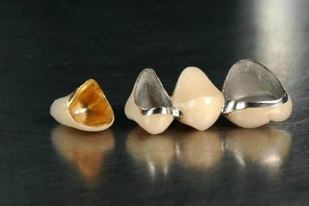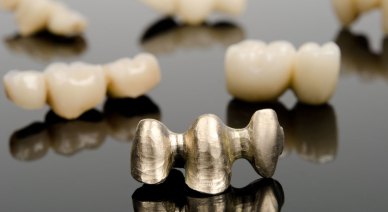METAL CERAMIC CROWNS
 Metal ceramic crowns are a traditional type of crown often used in bridges plus crown and bridge cases. They are often fitted onto back teeth and are considered a strong, robust type of crown. But they are viewed as less than attractive. Many people choose the all ceramic crowns, zirconium or the E-Max crown for their greater aesthetic appeal.
Metal ceramic crowns are a traditional type of crown often used in bridges plus crown and bridge cases. They are often fitted onto back teeth and are considered a strong, robust type of crown. But they are viewed as less than attractive. Many people choose the all ceramic crowns, zirconium or the E-Max crown for their greater aesthetic appeal.
WHAT IS A METAL CERAMIC CROWN? Another name for this is a ‘porcelain fused to metal’ crown. They consist of a metal interior or base which is fused to porcelain crowns. The metal interior can be produced from a range of metals, e.g. alloy and this is what gives this crown its strength.
ADVANTAGES OF METAL CERAMIC CROWNS This type of crown is both robust and long lasting. It is considered a better fit than many other types of crowns and to have greater strength as well. They are often cheaper than other types of crowns, for example all ceramic crowns. The cost of a crown depends upon the material/s used, the location in the jaw (e.g. front or back tooth) and the extent of the procedure. As you might imagine, the more crowns you need the longer this will take which will increase the cost.
DISADVANTAGES OF METAL CERAMIC CROWNS A disadvantage with this crown is that there is often a structural weakness in the ceramic crown. The crown can be prone to chipping or a fracture. There is a risk of this occurring due to the complexity of the fabrication procedure. There is a high degree of difficulty in producing metal crowns which increases the likelihood of this. Plus this is a thicker type of crown which can mean the dentist having to remove a larger portion of your affected tooth. Tooth reduction is a part of the preparation stage but the amount removed depends upon the state of the tooth and the type of crown being fitted. Increased tooth reduction can cause problems if this procedure has to be reversed sometime in the future. Finally, there is an aesthetic issue with metal ceramic crowns. What tends to happen is that the metal base begins to appear around the gum line or darkens the porcelain crown. This is more likely to occur in people who have receding gums but it is something to bear in mind when choosing a crown. There are people who dislike this obvious grey line around the edge of the crown and choose a ceramic crown instead.
 HOW ARE METAL CROWNS FITTED? These are fitted in a two step process. The first step involves a dental check up followed by the preparing of the tooth for the crown. The dentist will clean this tooth before reshaping it with a small drill so that it has a tapered appearance and is a good fit for the crown. This reshaping also helps to remove the signs of damage, decay or staining. The aim is to ensure that your tooth is in a good condition and ready to receive the crown. This is followed by an impression of your teeth. The dentist will take an impression of your teeth with a special mould which is filled with dental putty. He or she will ask you to bite down into this putty which will leave an accurate impression of your teeth. This impression is then sent away to a dental laboratory where it will be used in the fabrication of your metal crown. Expect to wait up to three weeks for this crown. Once your crown is ready you will return for the fitting. The dentist will insert the crown over your tooth before checking its appearance against a tooth color chart. He or she will also check the position and fitting. Once you are both happy with this, the dentist will then fix it in place with dental cement.
HOW ARE METAL CROWNS FITTED? These are fitted in a two step process. The first step involves a dental check up followed by the preparing of the tooth for the crown. The dentist will clean this tooth before reshaping it with a small drill so that it has a tapered appearance and is a good fit for the crown. This reshaping also helps to remove the signs of damage, decay or staining. The aim is to ensure that your tooth is in a good condition and ready to receive the crown. This is followed by an impression of your teeth. The dentist will take an impression of your teeth with a special mould which is filled with dental putty. He or she will ask you to bite down into this putty which will leave an accurate impression of your teeth. This impression is then sent away to a dental laboratory where it will be used in the fabrication of your metal crown. Expect to wait up to three weeks for this crown. Once your crown is ready you will return for the fitting. The dentist will insert the crown over your tooth before checking its appearance against a tooth color chart. He or she will also check the position and fitting. Once you are both happy with this, the dentist will then fix it in place with dental cement.